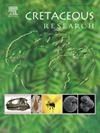First discovery of dinosaur tracks from the Lower Cretaceous Duoni Formation in eastern Tibet, China
IF 1.9
3区 地球科学
Q1 GEOLOGY
引用次数: 0
Abstract
Dinosaurs are known to have been abundant and diverse in eastern Tibet, and roamed the region from the Early Jurassic to the Late Cretaceous. Even though the evidence of dinosaurs is known throughout this interval, there are still many stratigraphic gaps that lack evidence, such as the Upper Jurassic and the Lower Cretaceous successions. Here, we report a new dinosaur tracksite from the Lower Cretaceous Duoni Formation of Basu County, where 28 track-bearing surfaces were discovered, which document a flourishing dinosaur community. Of these, three track layers with a high abundance of dinosaur tracks are described here, including sauropod, ornithopod and theropod trackways. These tracks suggest a possible exchange of trackmakers between this region and with adjacent areas of East Asia. The trackmakers' size, gait, and speed were inferred. The paleoenvironment is interpreted as ephemeral lakes bordered by conifer dominated forests. Palynological analysis conducted along the Duola stratigraphic section suggests that the tracksite is Aptian-Albian (Lower Cretaceous) in age, and the paleoclimate of the Basu area was relatively warm and dry.
在中国西藏东部下白垩统多尼地层首次发现恐龙足迹
众所周知,恐龙在西藏东部分布广泛,种类繁多,从早侏罗世到晚白垩世一直在该地区游荡。尽管在这一时期已知有恐龙的证据,但仍有许多地层空白缺乏证据,如上侏罗世和下白垩世的演替。在此,我们报告了巴苏县下白垩统多尼地层中的一处新恐龙足迹遗址,在该遗址中发现了28个带足迹的表面,记录了一个繁荣的恐龙群落。在这些足迹中,有三个足迹层含有大量恐龙足迹,包括长脚类、鸟脚类和兽脚类足迹。这些足迹表明,该地区与东亚邻近地区之间可能存在足迹制造者的交流。对履带制造者的体型、步态和速度进行了推断。古环境被解释为濒临针叶林的短暂湖泊。沿杜奥拉地层剖面进行的古生物学分析表明,足迹点的年代为安普世-阿尔比世(下白垩世),巴苏地区的古气候相对温暖干燥。
本文章由计算机程序翻译,如有差异,请以英文原文为准。
求助全文
约1分钟内获得全文
求助全文
来源期刊

Cretaceous Research
地学-地质学
CiteScore
4.10
自引率
19.00%
发文量
235
审稿时长
12 weeks
期刊介绍:
Cretaceous Research provides a forum for the rapid publication of research on all aspects of the Cretaceous Period, including its boundaries with the Jurassic and Palaeogene. Authoritative papers reporting detailed investigations of Cretaceous stratigraphy and palaeontology, studies of regional geology, and reviews of recently published books are complemented by short communications of significant new findings.
Papers submitted to Cretaceous Research should place the research in a broad context, with emphasis placed towards our better understanding of the Cretaceous, that are therefore of interest to the diverse, international readership of the journal. Full length papers that focus solely on a local theme or area will not be accepted for publication; authors of short communications are encouraged to discuss how their findings are of relevance to the Cretaceous on a broad scale.
Research Areas include:
• Regional geology
• Stratigraphy and palaeontology
• Palaeobiology
• Palaeobiogeography
• Palaeoceanography
• Palaeoclimatology
• Evolutionary Palaeoecology
• Geochronology
• Global events.
 求助内容:
求助内容: 应助结果提醒方式:
应助结果提醒方式:


